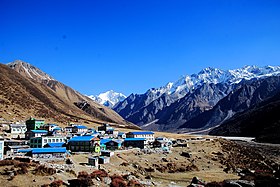Rasuwa District
Rasuwa District
रसुवा जिल्ला | |
|---|---|
District | |
|
Clockwise from top: Kyanjing Gompa village, Stupa near NPT) | |
| Main Language(s) | Nepali, Tamang |
Rasuwa District (
Etymology
The name, formerly Rasowa, is believed to be derived from two Tibetan words ra (lamb) and sowa (grazing), as it was known for its lamb and grazing lands.
Geography and climate
| Climate Zone[3] | Elevation Range | % of Area |
|---|---|---|
| Upper Tropical | 300 to 1,000 meters 1,000 to 3,300 ft. |
1.2% |
| Subtropical | 1,000 to 2,000 meters 3,300 to 6,600 ft. |
11.4% |
| Temperate | 2,000 to 3,000 meters 6,400 to 9,800 ft. |
20.8% |
Subalpine
|
3,000 to 4,000 meters 9,800 to 13,100 ft. |
20.0% |
Alpine
|
4,000 to 5,000 meters 13,100 to 16,400 ft. |
11.8% |
| Nival | above 5,000 meters | 32.9% |
| Transhimalayan[4] | Cold arid or semi-arid | 2.0% |
Its territory has elevations ranging from 614 to 7,227 meters (2,014 to 23,711 ft) from mean
Demographics
| Census year | Pop. | ±% p.a. | ||
|---|---|---|---|---|
| 1981 | 30,241 | — | ||
| 1991 | 36,744 | +1.97% | ||
| 2001 | 44,731 | +1.99% | ||
| 2011 | 43,300 | −0.32% | ||
| 2021 | 45,554 | +0.51% | ||
| ||||
| Source: Citypopulation[7] | ||||
At the time of the 2011 Nepal census, Rasuwa District had a population of 43,300.
As their first language, 68.2% spoke
Ethnicity/caste: 69.6% were Tamang, 15.2% Hill Brahmin, 3.1% Gurung, 2.4% Ghale, 2.3% Newar, 2.0% Chhetri, 1.9% Kami, 1.2% Magar, 1.0% Damai/Dholi, 0.2% Yolmo, 0.1% Badi, 0.1% Gharti/Bhujel, 0.1% Sherpa and 0.7% others.[9]
Religion: 70.0% were Buddhist, 25.4% Hindu, 4.3% Christian, 0.1% Prakriti and 0.3% others.[10]
Literacy: 52.3% could read and write, 3.0% could only read and 44.6% could neither read nor write.[11]
Administrative divisions
The administrative division of Rasuwa comprised 5 Rural Municipalities.

Following are five Rural Municipalities in Rasuwa District:
| # | Name | Website |
|---|---|---|
| 1 | Uttargaya Rural Municipality | uttargayamun |
| 2 | Kalika Rural Municipality | kalikamunrasuwa |
| 3 | Gosaikunda Rural Municipality | gosaikundamun |
| 4 | Naukunda Rural Municipality | naukundamun |
| 5 | Aamachhodingmo Rural Municipality | aamachhodingmomun |
Many leaders of different parties are here but only 5 mayors are here. Nepali Congress won 2 places,
CPN UML won 2 place and Rastriya Prajatantrik Party won 1 seat/place. The first ever person who
was elected in Rasuwa from Nepali Congress was Mr. Bal Chandra Poudel (2046 B.S). The history of other
parties are not commenced yet but this district in Nepal is also the one with no VDC. The winner of election
2070 BS in this district is Mr. Janardan Dhakal.
Transportation
Rasuwa is accessible by bus from Kathmandu (national capital) via Pasang Lhamu highway (H21), with its headquarters (Dhunche) being about 120 km (75 mi) from Kathmandu. As of 2013, 3 VDCs[clarification needed] namely Thuman, Langtang and Haku are not touched by any kind of roadway.
Tourism

Rasuwa is rich in natural resources.[citation needed] Langtang mountain range stands to the north of Rasuwa. The northern parts of the area largely fall within the boundaries of Langtang National Park. Gosainkunda Lake, Ganja La Pass, and Tamang village in Bridim are the major highlights of Rasuwa for tourism. The Gosainkunda Lake, also known as "Frozen Lake", is a mountain lake in the Langtang region. There are about 108 kundas (lakes) in this area. Saraswati Kund, Bhairab Kund, Surya Kund and Gosainkund are most important ones.
References
- ^ "Rasuwa". nepalmap.org. Retrieved 26 December 2020.
- Ministry of Federal Affairs and Local Development. Retrieved 17 July 2018.
- ^
The Map of Potential Vegetation of Nepal - a forestry/agroecological/biodiversity classification system (PDF), Forest & Landscape Development and Environment Series 2-2005 and CFC-TIS Document Series No. 110, 2005, ISBN 87-7903-210-9, retrieved Nov 22, 2013
- ^ Shrestha, Mani R.; Rokaya, Maan B.; Ghimire, Suresh K. (2005). "Vegetation pattern of Trans-Himalayan zone in the North-West Nepal". Nepal Journal of Plant Sciences. 1: 129–135. Retrieved Feb 7, 2014.
- ^ Banerji, Gargi; Basu, Sejuti. "Climate Change and Himalayan Cold Deserts: Mapping vulnerability and threat to ecology and indigenous livelihoods" (PDF). Pragya. Gurgaon, Haryana, India. Retrieved February 7, 2014.
- ^ Environment Statistics of Nepal, 2011 Archived 2013-09-25 at the Wayback Machine
- ^ "NEPAL: Administrative Division". www.citypopulation.de.
- ^ NepalMap Language [1]
- ^ NepalMap Caste [2]
- ^ NepalMap Religion [3]
- ^ NepalMap Literacy [4]
- Rasuwa District Profile 2011
- "Districts of Nepal". Statoids.





